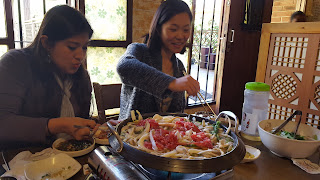Asian Cooking in Guatemala
For a long time now, Karina and Jin (a teacher/neighbor originally from China) had been talking about getting a group together so Jin could teach us how to make a few Chinese dishes. The day finally came this weekend.
On Saturday morning, Karina, Jin, Karen, and I took off at 10:30am to go shopping for ingredients.
Our first stop was the Chinese store. Watching Jin walk in, it was like watching a kid in a candy shop. It was like she was home. She was ecstatic to see all of the ingredients. “Look how great those mushrooms look!” “Ooh, with those noodles you could make…” “This is my favorite brand of soy sauce!” It was great, and just following her around was a lesson in Chinese cuisine, though I’ll remember none of it in the future.
From there, we went to zone 7. By this time, we were getting hungry, so we went to Jin’s favorite Korean restaurant. Pro tip: if you want the best service at a Korean restaurant in Guatemala City, take someone with you who can speak Korean and order in Korean. It’s not a myth that they serve foreigners differently, according to Jin, who has it from the Korean parents at our school.
Since we all have gotten Korean BBQ enough times to know what and how to order and eat that, Jin decided perhaps we should try something new, so we ordered a soup, which we cooked over a burner at our table, and that came with all the little side dishes that also come with the meat when you cook that. Our meal was absolutely delicious, and we left stuffed.
Back in La Joya, we started on the kimchi around 4pm. Jin mixed together the marinade for the cabbage: a huge amount of red pepper flakes, rice porridge, green onions, garlic, ginger, and anchovy sauce.
 |
| "That much red pepper? Really?" |
 When that was done, we got out the cabbage (which had been salted hours earlier to drain out the water). Jin showed us how to spread the paste on each layer, then wrap it up. From there, the cabbages would go into an airtight container. They’ll stay there for two weeks, fermenting, and when they’re smelling nice and ripe, we’ll be ready to eat them!
When that was done, we got out the cabbage (which had been salted hours earlier to drain out the water). Jin showed us how to spread the paste on each layer, then wrap it up. From there, the cabbages would go into an airtight container. They’ll stay there for two weeks, fermenting, and when they’re smelling nice and ripe, we’ll be ready to eat them!
After the kimchi was prepared and put away, we began on Chinese dumplings. We mixed up the stuffing, which turned out to be the easy part. Jin kept telling us dumplings would go quickly and easily, because we’d just have to wrap them. We planned to make around 250 between the six of us.
Fun fact: Chinese dumplings are tricky little buggers.
A few of us were used to making perogies (gloriously stretchy dough that you fill and pinch the edges together to seal), and some had made ravioli (pasta dough laid over a form, filled, and then pinched with a second layer of dough). None of us were prepared for the intricate folding and sealing of the delicate dumpling wrappers.
 |
| What the dumpling SHOULD look like |
Most of our dumplings looked nowhere near as beautiful as Jin’s, and even the ones that we thought we’d done well on busted open when we boiled them. While I tried to perfect the cute dumpling folding Jin had showed us, others got creative...trying out “tacos” and “empanadas” and cute little twisted packets. We may have failed at dumpling making (and we called it a night after wrapping only 106 of them), but we certainly had fun and laughed a lot in our attempt. And, while the dumplings split open and became waterlogged when we tried to boil them, they still tasted pretty darn good.

For all those reasons--I definitely count our Saturday lesson in Asian cooking a success!









Comments
Post a Comment